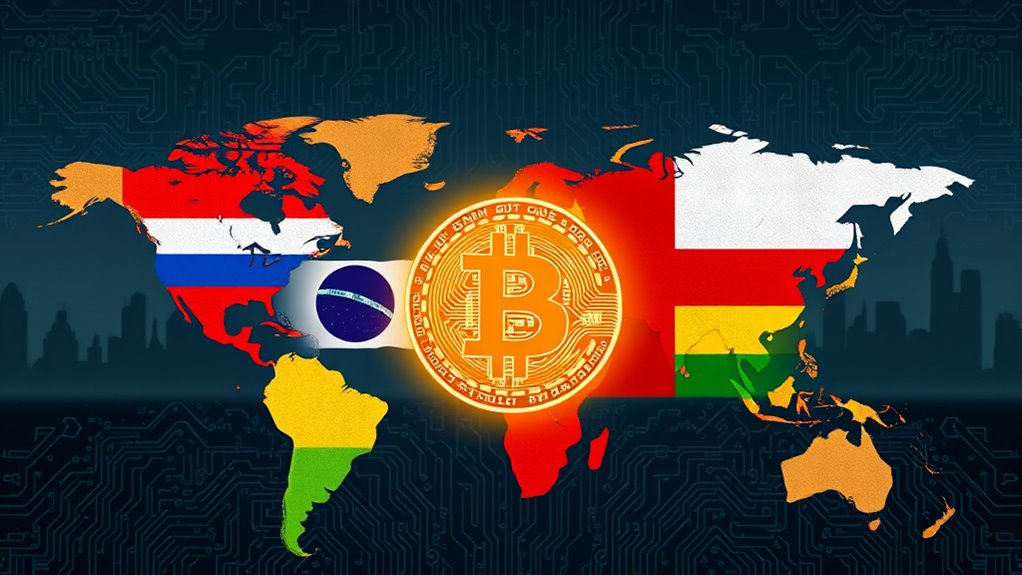BRICS countries like Russia are turning to Bitcoin and stablecoins as Western sanctions push them to seek alternatives to the U.S. dollar. This shift allows them to conduct cross-border trade, reducing reliance on traditional banking systems. As they explore new payment frameworks, the demand for stablecoins rises, reshaping financial dynamics globally. This movement toward financial sovereignty comes with challenges, but the impact could redefine international trade. You might want to explore the implications further.
Key Takeaways
- BRICS nations, including Russia and China, are leveraging Bitcoin to establish alternative financial systems and reduce reliance on the U.S. dollar.
- Russia’s legalization of crypto for foreign trade aims to bypass Western sanctions and enhance economic sovereignty among BRICS countries.
- The rising demand for stablecoins among BRICS nations reflects a shift toward alternative currencies for cross-border transactions amid market volatility.
- Blockchain technology is facilitating more efficient and transparent international trade, reshaping geopolitical alliances and economic strategies within BRICS and beyond.
- Regulatory uncertainties and security concerns may hinder broader adoption of Bitcoin and crypto solutions in global trade among BRICS nations.
The Impact of Sanctions on Russia’s Crypto Policy

As Western sanctions increasingly tightened around Russia, the nation recognized the need for alternative financial mechanisms, leading to its groundbreaking crypto policy shift. You might see this move as a direct response to restricted access to SWIFT and dollar-based systems. By legalizing crypto for foreign trade, Russia aims to reduce its reliance on the U.S. dollar and euro, enabling cross-border transactions with “friendly” nations. This shift not only represents a tactical maneuver against sanctions but also aligns with the broader BRICS goal of establishing a financial system independent of Western dominance. As you consider the implications, think about how this could reshape global trade dynamics and inspire other nations facing similar challenges to explore crypto solutions. Furthermore, the adoption of alternative financial mechanisms like cryptocurrency could significantly enhance economic resilience in these nations.
Understanding the “Experimental Regime” for Crypto Trade

As you explore the “experimental regime” for crypto trade in Russia, you’ll notice a legal framework that sets clear boundaries for participation. Only approved businesses can engage in international transactions using Bitcoin and stablecoins, which raises questions about the economic impacts on both domestic and global markets. Understanding these criteria will help you grasp how this initiative might reshape trade dynamics. Furthermore, this situation highlights the importance of embracing failure in creativity, as businesses navigate the uncertainties of a rapidly evolving financial landscape.
Legal Framework Overview
While the legalization of cryptocurrency for foreign trade in Russia marks a significant policy shift, understanding the framework of the “experimental regime” that governs this initiative is essential. This regime allows approved Russian businesses to engage in international trade using Bitcoin and select stablecoins, but it doesn’t permit crypto for domestic purchases. Set to last three years, with the possibility of extension, this framework is overseen by the Bank of Russia, the Finance Ministry, and the Federal Financial Monitoring Service. The primary currency for domestic use remains the ruble, ensuring that crypto is specifically reserved for cross-border transactions. This legal structure aims to enhance trade flexibility while addressing the challenges posed by Western sanctions and global financial dynamics. Moreover, the implementation of this framework may impact bank SWIFT codes as businesses adapt to new methods of international transactions.
Participation Criteria Explained
How can businesses participate in Russia’s new crypto trade framework? To engage, you must be an approved Russian entity and focus on specified cryptocurrencies like Bitcoin and certain stablecoins. This “experimental regime” lasts for three years, managed by the Bank of Russia and other regulatory bodies. It’s vital to confirm your crypto transactions are for international trade only, as domestic crypto use isn’t allowed. You’ll need to stay informed about compliance requirements and potential regulatory changes, as the framework is still evolving. Remember, only select asset types are authorized, so check that your chosen cryptocurrencies meet the criteria. Participating in this framework can offer new avenues for cross-border transactions amid shifting global financial landscapes. Additionally, understanding total-cost clarity can help businesses evaluate the financial implications of their crypto involvement.
Potential Economic Impacts
Understanding the implications of Russia’s “experimental regime” for crypto trade can help you navigate the evolving landscape of international commerce. By allowing approved businesses to use Bitcoin and stablecoins for international settlements, Russia aims to bypass Western sanctions and reduce reliance on the U.S. dollar. This shift could lead to increased demand for cryptocurrencies, particularly among BRICS nations looking to establish their own trade frameworks. However, the regime’s regulatory uncertainty and limited participant scope may restrict broader adoption. As these nations experiment with crypto, expect volatility and potential geopolitical tensions. Your ability to adapt to these changes could position you advantageously in the future of global trade, where decentralized systems may redefine traditional financial structures. Additionally, fostering dynamic communication exercises among partners involved in crypto trade can enhance collaborative efforts and understanding in this complex environment.
The Role of BRICS in Shaping Global Financial Alternatives

As BRICS nations actively pursue alternatives to traditional financial systems, they’re reshaping global finance in significant ways. You’re witnessing a shift where countries like Russia, China, and India are exploring cryptocurrency and blockchain technologies, aiming to minimize reliance on the U.S. dollar. By developing new payment systems and embracing digital currencies, they’re challenging Western financial dominance. This movement not only offers greater financial sovereignty but also encourages innovation in financial technologies. You might see increased collaboration among BRICS members, making cross-border trade easier and more efficient. As these countries navigate through sanctions and economic pressures, their collective efforts could give rise to a more diversified and resilient global financial ecosystem, impacting how you engage with international markets. Furthermore, their strategies may incorporate predictive analytics to enhance transaction security and efficiency in digital currencies.
Analyzing the Demand for Stablecoins in International Trade

As countries like Russia embrace crypto for international trade, you might wonder how stablecoins fit into this new landscape. The growing demand for stablecoins reflects a desire for stability amid market volatility and regulatory uncertainties. Understanding these adoption trends and the challenges ahead is essential to grasping their role in the future of global trade. Additionally, astrological charts can provide deeper insights into the economic behaviors of nations, influencing their approach to crypto adoption.
Stablecoin Adoption Trends
While the landscape of international trade evolves, the demand for stablecoins is rapidly gaining traction, especially among nations looking to circumvent traditional banking systems. Countries are increasingly adopting stablecoins for cross-border transactions, driven by the need for stability and reduced volatility.
| Factors Influencing Adoption | Examples of Stablecoins | Potential Benefits |
|---|---|---|
| Regulatory Support | USDT | Lower transaction costs |
| Volatility Hedging | USDC | Faster settlement times |
| Cross-Border Transactions | DAI | Increased financial inclusion |
As trade dynamics shift, stablecoins offer a viable alternative to traditional currencies, enabling smoother transactions and greater financial autonomy. This trend signals a broader acceptance of crypto within international trade frameworks. Moreover, the integration of anti-aging effects in financial systems may enhance the overall resilience and adaptability of these currencies.
Regulatory Challenges Ahead
Despite the growing interest in stablecoins for international trade, regulatory challenges loom large. You’ll find that many countries are still figuring out how to approach cryptocurrency regulations, leading to uncertainty for businesses. For instance, while Russia allows limited crypto use for foreign trade, only selected firms can participate, and domestic transactions remain off-limits. This creates a fragmented landscape where compliance can be tricky. Additionally, concerns about volatility and security risks make many hesitant to fully embrace stablecoins. As nations grapple with these regulatory hurdles, the future demand for stablecoins in cross-border transactions may hinge on how effectively these challenges are addressed. Without clear regulations, the potential benefits of stablecoins could remain untapped. Moreover, enhancing career and lifestyle choices through the adoption of stablecoins could provide new opportunities for businesses navigating this complex environment.
Market Demand Insights
How do stablecoins fit into the evolving landscape of international trade? As countries like Russia adopt crypto for cross-border transactions, demand for stablecoins is on the rise. You’ll notice that stablecoins like USDT and USDC offer a solution to reduce volatility, making them appealing for international trade settlements. With Russia’s move to legalize stablecoins for foreign trade, businesses are looking for ways to bypass traditional banking systems, especially amid sanctions. This shift could lead to increased adoption among BRICS nations, as they seek alternatives to the U.S. dollar. As these currencies gain traction, you might find blockchain technology increasingly replacing conventional transaction methods, potentially reshaping global trade dynamics.
Challenges Facing Russia’s Crypto Adoption for Trade Settlements

What challenges does Russia face in adopting crypto for trade settlements? First, only selected businesses can engage in crypto transactions, limiting participation and innovation. You’ll also notice that the regulatory environment remains uncertain, as the “experimental regime” is untested, potentially hindering broader adoption. Additionally, the volatility of cryptocurrencies raises concerns about security and consumer protection, which could deter businesses from fully committing to this new system. You can’t ignore the risk of Western sanctions either; they might impose even stricter restrictions on Russia’s crypto initiatives. Finally, the long-term sustainability of using crypto in trade settlements is still unclear, leaving many unsure about the future of this approach in a rapidly evolving financial landscape. Moreover, the performance metrics of cryptocurrencies, such as price stability and transaction speed, are critical factors that influence their viability for trade settlements.
The Emergence of Blockchain Technology in Cross-Border Transactions

As Russia navigates the challenges of adopting crypto for trade settlements, blockchain technology emerges as a promising solution for enhancing cross-border transactions. You’ll find that blockchain offers transparency, security, and efficiency, making it an ideal choice for international trade. By leveraging smart contracts, transactions can be automated, reducing delays and costs. This technology allows businesses to bypass traditional banking systems, facilitating faster settlements while minimizing the risk of fraud. As more BRICS nations consider blockchain for their trade, you may notice a shift in how countries interact economically. The decentralized nature of blockchain empowers you to engage in trade with fewer intermediaries, ultimately changing the landscape of global commerce. Embracing this innovation could redefine your approach to international transactions.
Future Prospects for the BRICS Bridge Payment System

While the BRICS Bridge payment system aims to revolutionize cross-border trade by offering an alternative to traditional banking channels, its future prospects hinge on several critical factors. First, regulatory clarity will be essential for attracting businesses to participate. If governments impose strict limitations, growth could stall. Second, technological infrastructure needs to be robust; any glitches could undermine trust. Additionally, the global political landscape plays a significant role; ongoing tensions may influence adoption rates. Finally, the system’s ability to maintain stability against market volatility will determine its long-term viability. If successful, the BRICS Bridge could reshape international trade dynamics, promoting financial sovereignty among member nations and reducing dependence on Western systems.
Geopolitical Implications of Crypto-Driven Trade

The emergence of crypto-driven trade is reshaping the geopolitical landscape, particularly as countries explore alternatives to existing financial systems. You’ll notice nations like Russia leveraging cryptocurrencies to sidestep sanctions and reduce reliance on the U.S. dollar. This shift could empower other countries within BRICS to adopt similar tactics, fostering a decentralized approach to global trade. Increased crypto adoption might also lead to heightened market volatility and geopolitical tensions as nations navigate this uncharted territory. As traditional financial systems face challenges, you may see a rise in demand for stablecoins and privacy-focused cryptocurrencies. Ultimately, these developments could redefine international trade dynamics, challenging Western financial dominance and paving the way for new alliances.
The Potential for Financial Sovereignty Among Sanctioned Nations

Given the increasing pressure from international sanctions, sanctioned nations are finding potential pathways to financial sovereignty through the adoption of cryptocurrencies. By embracing digital currencies, these countries can bypass traditional banking systems and maintain vital trade relationships. For instance, Russia’s recent legalization of crypto for foreign trade demonstrates this shift, allowing specific businesses to engage in cross-border transactions without relying on the U.S. dollar or SWIFT. This move not only reflects an effort to mitigate the impact of sanctions but also aligns with broader BRICS initiatives aimed at reducing dependence on Western financial systems. As more countries explore similar strategies, cryptocurrencies may become essential tools for achieving economic independence and fostering resilient trade networks.
Navigating the Risks of a Decentralized Global Trade System

As nations embrace decentralized trade systems, steering through the inherent risks becomes essential for ensuring stability and security in global commerce. You’ll need to remain vigilant as these new frameworks unfold, as several challenges emerge:
- Volatility: Prices can swing dramatically, impacting profits and planning.
- Regulatory Uncertainty: Changing laws may create confusion and hinder operations.
- Security Risks: Cyber threats can compromise transactions and data integrity.
- Consumer Protections: Lack of safeguards leaves users vulnerable to fraud.
- Geopolitical Tensions: Conflicts may escalate, affecting trade relationships.
Frequently Asked Questions
How Will Russia Regulate Cryptocurrencies During the Experimental Regime?
During the experimental regime, Russia regulates cryptocurrencies by allowing only approved businesses to use Bitcoin and specific stablecoins for international trade. You’ll see oversight from the Bank of Russia, the Finance Ministry, and the Federal Financial Monitoring Service. While the ruble remains the primary currency domestically, this framework aims to facilitate cross-border transactions without affecting local purchases. Expect strict compliance measures and defined asset types to guarantee controlled use of crypto in trade.
What Specific Stablecoins Are Approved for International Trade in Russia?
Like a key opening new doors, Russia’s approval for international trade includes specific stablecoins such as USDT and USDC. You’ll find that only these and other designated digital financial assets can facilitate cross-border transactions under the new law. While the focus is on approved Russian businesses, it’s essential to stay informed about which stablecoins might gain traction in this evolving landscape as the experimental regime unfolds.
Which Russian Businesses Can Participate in Crypto Trade Settlements?
Only approved Russian businesses can participate in crypto trade settlements, and these include firms that meet specific regulatory criteria set by the government. You’ll need to check if your business qualifies under the guidelines established by the Bank of Russia and other regulatory bodies. Keep in mind that this framework is limited to international trade; domestic transactions still rely on the ruble. Make sure to stay updated on any changes that may affect participation.
How Does Crypto Help Russia Bypass Western Sanctions?
Imagine maneuvering a maze with walls of sanctions closing in. Crypto becomes your secret passageway, allowing you to sidestep traditional banking barriers. For Russia, it’s a lifeline, enabling international trade without relying on the U.S. dollar or euro. You can transact with “friendly” nations using Bitcoin and stablecoins, keeping your economic engine running smoothly. This digital currency landscape opens doors, offering a way to thrive amidst financial isolation.
What Are the Implications for Consumer Protection in Crypto Transactions?
The implications for consumer protection in crypto transactions are significant. You face heightened risks due to volatility, security vulnerabilities, and lack of regulatory oversight. Without established protections, you might encounter fraud or loss of funds more easily. It’s vital to stay informed and use reputable platforms. As the landscape evolves, you should advocate for stronger regulations and safeguards to guarantee your interests are protected in this rapidly changing environment.
Conclusion
In the ever-changing landscape of global finance, BRICS and crypto are shaking things up. As nations explore new paths to financial sovereignty, it’s clear that the rules of the game are changing. While challenges exist, the push for decentralized trade systems could be a game-changer for sanctioned countries. If you’re not paying attention, you might miss the boat on how these shifts could redefine international markets and the future of cryptocurrency.









